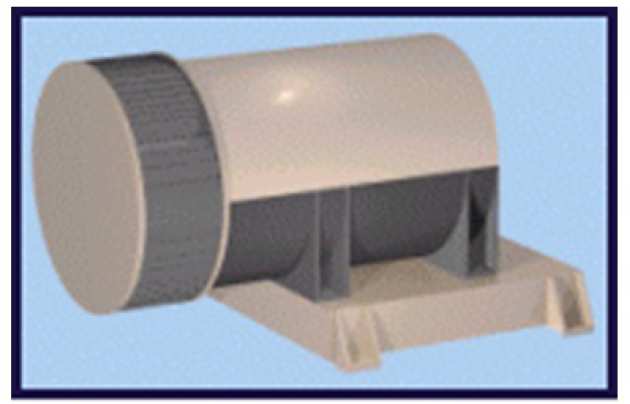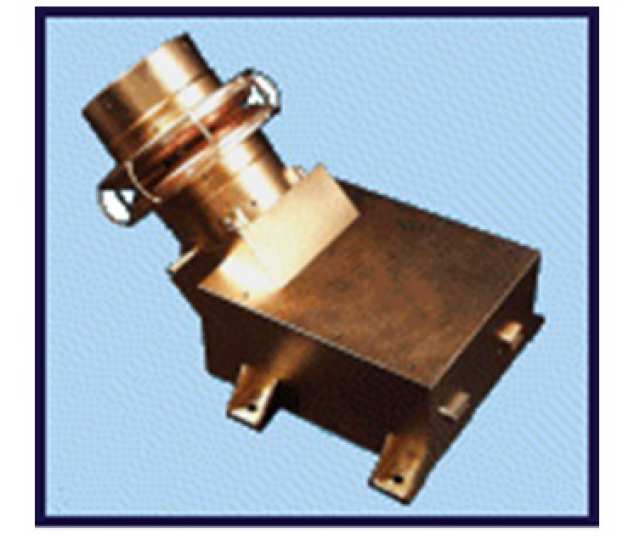Rosetta RPC Sensors
- Ion Composition Analyser (ICA)
- Ion and Electron Sensor (IES)
- Langmuir probe Instrument (LAP)
- Fluxgate Magnetometer (MAG)
- Mutual Impedance Probe (MIP)
 The Ion Composition Analyser measures the distribution function of positive ions. The instrument resolves the 3-D velocity distribution of cometary and solar wind ions, with a mass resolution high enough to resolve the major species such as protons, helium, oxygen, molecular ions, and heavy ions clusters (dusty plasma). The 2.0 kg instrument consists of an electrostatic arrival angle filter, an electrostatic energy filter, and a magnetic momentum filter. Particles are detected using a large diameter (100 mm) microchannel plate and a 2-D anode system. ICA has its own processor for data reduction/compression and formatting.
The Ion Composition Analyser measures the distribution function of positive ions. The instrument resolves the 3-D velocity distribution of cometary and solar wind ions, with a mass resolution high enough to resolve the major species such as protons, helium, oxygen, molecular ions, and heavy ions clusters (dusty plasma). The 2.0 kg instrument consists of an electrostatic arrival angle filter, an electrostatic energy filter, and a magnetic momentum filter. Particles are detected using a large diameter (100 mm) microchannel plate and a 2-D anode system. ICA has its own processor for data reduction/compression and formatting.
The ICA is provided by the Swedish Institute of Space Physics, Sweden. Principal Investigator: R. Lundin.
Image on the right: ICA spherical electrostatic analyser with a magnetic mass analyser (R. Ludin)
 The Ion and Electron Sensor consists of two electrostatic analysers, one each for electrons and ions, which share a common entrance aperture. The charged particle optics for IES employ a toroidal top-hat geometry along with electrostatic angle deflectors to achieve an electrostatically scanned field of view of 90 x 360 degrees. The large field of view will be used to measure the ions and electrons of the solar wind, ions and electrons in the cometary coma, and sputtered ions and photoelectrons generated on the cometary nucleus.
The Ion and Electron Sensor consists of two electrostatic analysers, one each for electrons and ions, which share a common entrance aperture. The charged particle optics for IES employ a toroidal top-hat geometry along with electrostatic angle deflectors to achieve an electrostatically scanned field of view of 90 x 360 degrees. The large field of view will be used to measure the ions and electrons of the solar wind, ions and electrons in the cometary coma, and sputtered ions and photoelectrons generated on the cometary nucleus.
The IES is provided by the Southwest Research Institute, Texas. Principal Investigator: J. Burch
Image on the right: IES toroidal electrostatic analyser to measure ion and electron distribution functions (J. Burch)
--tojpeg_1446645867416_x2.jpg) The dual Langmuir probe instrument has as its prime objectives to study the plasma density, temperature and flow velocity. It comprises two spherical sensors mounted at the tip of the deployable booms, and the sensors can be swept in potential to measure the current-voltage characteristic which provides information on the electron number density and temperature. The probes can be held at a fixed bias potential to measure plasma density fluctuations from structures in the plasma, and by a time-of-flight analysis of the signals from the two probes the plasma flow velocity is determined. In the inner coma we expect a close coupling to the neutral gas, and the measurement thus provides information on the neutral gas flow.
The dual Langmuir probe instrument has as its prime objectives to study the plasma density, temperature and flow velocity. It comprises two spherical sensors mounted at the tip of the deployable booms, and the sensors can be swept in potential to measure the current-voltage characteristic which provides information on the electron number density and temperature. The probes can be held at a fixed bias potential to measure plasma density fluctuations from structures in the plasma, and by a time-of-flight analysis of the signals from the two probes the plasma flow velocity is determined. In the inner coma we expect a close coupling to the neutral gas, and the measurement thus provides information on the neutral gas flow.
The LAP is provided by the Swedish Institute of Space Physics, Sweden. Principal Investigator: A. Eriksson
Image on the right: LAP spherical Langmuir probe, 5cm in diameter, made of titanium (R. Bostrom)
--tojpeg_1446646131787_x2.jpg) The MAG experiment aims to measure the magnetic field in the interaction region between the solar wind plasma and the comet. It consists of two ultra light (about 28g each) triaxial fluxgate magnetometer sensors mounted close to the tip of the spacecraft boom pointing away from the cometary nucleus and about 10 to 30 cm closer to the spacecraft body (see Fig. 4). Two sensors are required to minimize the influence of the spacecraft magnetic field and for redundancy reasons. The measurement range is +/- 16,384 nT with steps of +/- 0.031 nT. They will be operated with a high time resolution of about 50 vectors/s, the achieved bandwidth is thus 0-25 Hz. These performances will allow detailed analysis of magnetic field variations. RPC/MAG is furthermore designed to study possible remnant magnetic field of the nucleus, measurements done in close cooperation with the lander magnetometer experiment ROMAP.
The MAG experiment aims to measure the magnetic field in the interaction region between the solar wind plasma and the comet. It consists of two ultra light (about 28g each) triaxial fluxgate magnetometer sensors mounted close to the tip of the spacecraft boom pointing away from the cometary nucleus and about 10 to 30 cm closer to the spacecraft body (see Fig. 4). Two sensors are required to minimize the influence of the spacecraft magnetic field and for redundancy reasons. The measurement range is +/- 16,384 nT with steps of +/- 0.031 nT. They will be operated with a high time resolution of about 50 vectors/s, the achieved bandwidth is thus 0-25 Hz. These performances will allow detailed analysis of magnetic field variations. RPC/MAG is furthermore designed to study possible remnant magnetic field of the nucleus, measurements done in close cooperation with the lander magnetometer experiment ROMAP.
The MAG is provided by the Institute of Geophysics and Meteorology, Technical University of Braunschweig Germany. Principal Investigator: K. Glassmeier
Image on the right: MAG ultra light triaxial fluxgate magnetomerter (K. H. Glassmeier)
--tojpeg_1446646360158_x2.jpg) The Mutual Impedance Probe will measure the aeronomical parameters, electron density and temperature, as well as plasma flow velocity in the inner coma. In addition, MIP will investigate natural waves in the 7 kHz-3.5 MHz frequency range and monitor the dust and gas activity of the nucleus. A light electrical sensor made of fibre carbon and an electronics board makes up the MIP instrument. The MIP performance has the virtue of being independent of the chemical composition and photoemissive properties of its electrodes and is immune from contamination by dust and ice deposits. The extremely low energetic plasmas expected within the contact surface can then be explored.
The Mutual Impedance Probe will measure the aeronomical parameters, electron density and temperature, as well as plasma flow velocity in the inner coma. In addition, MIP will investigate natural waves in the 7 kHz-3.5 MHz frequency range and monitor the dust and gas activity of the nucleus. A light electrical sensor made of fibre carbon and an electronics board makes up the MIP instrument. The MIP performance has the virtue of being independent of the chemical composition and photoemissive properties of its electrodes and is immune from contamination by dust and ice deposits. The extremely low energetic plasmas expected within the contact surface can then be explored.
The MIP is provided by the Laboratoire de Physique et Chimie de l'Environnement, France. Principal Investigator: J. Trotignon
Image on the right: MIP electric antenna, 1m long, including two transmitting and two receiving electrodes (J. G. Trotignon)
Useful Links
Rosetta Links: